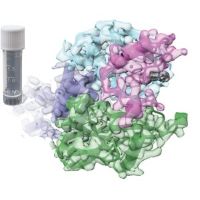Specification
| Description | Recombinant protein from the full-length sequence of Homo sapiens interleukin 10 receptor subunit beta (IL10RB) (NM_000628). |
| Organism | Homo sapiens (Human) |
| Expression Host | Human Cells |
| Tag Info | His or DYKDDDDK. Please contact us if you need further information or require specific designed tag. |
| Purity | Greater than 90% by SDS-PAGE gel |
| Uniprot ID | Q08334 |
| Entry Name | I10R2_HUMAN |
| Gene Names | IL10RB CRFB4 D21S58 D21S66 |
| Alternative Gene Names | CRFB4 D21S58 D21S66 |
| Alternative Protein Names | Interleukin-10 receptor subunit beta (IL-10 receptor subunit beta) (IL-10R subunit beta) (IL-10RB) (Cytokine receptor class-II member 4) (Cytokine receptor family 2 member 4) (CRF2-4) (Interleukin-10 receptor subunit 2) (IL-10R subunit 2) (IL-10R2) (CD antigen CDw210b) |
| Application | Antigens, Western, ELISA and other in vitro binding or in vivo functional assays, and protein-protein interaction studies; For research & development use only! |
| Buffer | Purified protein formulated in a sterile solution of PBS buffer, pH7.2, without any preservatives |
| Endotoxin | Endotoxin level is < 0.1 ng/µg of protein (<1EU /µg) |
| Length | 325 |
| Molecular Weight(Da) | 36995 |
| Protein Sequence | (The sequence of expressed protein may have some variation from the sequence shown below. Please contact us for the exact sequence.) MAWSLGSWLGGCLLVSALGMVPPPENVRMNSVNFKNILQWESPAFAKGNLTFTAQYLSYRIFQDKCMNTTLTECDFSSLSKYGDHTLRVRAEFADEHSDWVNITFCPVDDTIIGPPGMQVEVLADSLHMRFLAPKIENEYETWTMKNVYNSWTYNVQYWKNGTDEKFQITPQYDFEVLRNLEPWTTYCVQVRGFLPDRNKAGEWSEPVCEQTTHDETVPSWMVAVILMASVFMVCLALLGCFALLWCVYKKTKYAFSPRNSLPQHLKEFLGHPHHNTLLFFSFPLSDENDVFDKLSVIAEDSESGKQNPGDSCSLGTPPGQGPQS |
Background
| Function | FUNCTION: Shared cell surface receptor required for the activation of five class 2 cytokines: IL10, IL22, IL26, IL28, and IFNL1. The IFNLR1/IL10RB dimer is a receptor for the cytokine ligands IFNL2 and IFNL3 and mediates their antiviral activity. The ligand/receptor complex stimulate the activation of the JAK/STAT signaling pathway leading to the expression of IFN-stimulated genes (ISG), which contribute to the antiviral state. {ECO:0000269|PubMed:12469119, ECO:0000269|PubMed:15123776}. |
| Pathway | |
| Protein Families | Type II cytokine receptor family |
| Tissue Specificity |
QC Data
| Note | Please contact us for QC Data |
| Product Image (Reference Only) |  |

